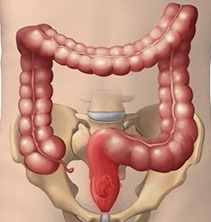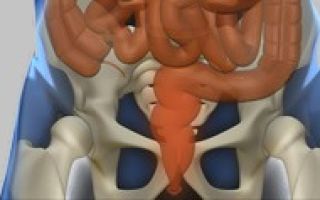Proctitis is an inflammation of the rectal mucosa.

Content
Reasons for the development of the disease
Often proctitis is one of the manifestations of inflammatory diseases of the colon: ulcerative colitis , Crohn's disease or dysentery .
Inflammation of the rectum can develop in patients who have undergone rectal surgery, for example, for hemorrhoids , anal fissures , or paraproctitis .
Proctitis can occur in patients with acute intestinal infections caused by campylobacter, chlamydia, herpes viruses and cytomegalovirus.
The cause of proctitis can also be pathogens of sexually transmitted diseases: gonorrhea and syphilis.
Inflammation of the rectal mucosa is sometimes caused by treatment with antibiotics, radiation therapy, and the use of enemas with irritating substances.
Symptoms
Proctitis can affect the lower segment of the rectum, 5-7 cm from the anus, sometimes spreading to the entire rectum. The skin around the anus is also often affected.
According to the manifestation of symptoms and the nature of the course of proctitis, they are distinguished:
- acute proctitis,
- chronic proctitis.
Symptoms of acute proctitis
Acute proctitis begins suddenly and is accompanied by the following symptoms:
- increased body temperature,
- chills,
- tenesmus (false urge to defecate) due to constipation,
- a feeling of heaviness in the rectum,
- severe burning in the rectum.
Acute proctitis develops quite rarely, but when this form of the disease occurs, it causes a lot of suffering to the patient.
Symptoms of chronic proctitis
Chronic proctitis, unlike acute proctitis, occurs frequently. The disease develops gradually, unnoticeably. There are no general symptoms. Local symptoms are not clearly expressed:
- itching in the anus,
- getting wet,
- burning.
These signs appear individually or in various combinations. As a rule, the manifestations are so insignificant that patients do not consult a doctor, continue to lead their usual lifestyle, or are treated with home remedies.
Meanwhile, the inflammatory process continues to develop. It manifests itself as an increased burning sensation in the rectum when eating spicy food, and mucous or mucopurulent discharge appears. Sometimes the most pronounced itching is in the anus. In this case, intestinal functions are not impaired.

Symptoms of ulcerative proctitis
With ulcerative proctitis, multiple erosions or even ulcers are detected on the rectal mucosa.
Ulcerative proctitis is a form of ulcerative colitis, but the symptoms and treatment methods are similar to proctitis, since the disease affects a segment or the entire rectum and does not spread further.
The symptoms of the disease are very characteristic:
- sudden appearance of drops of blood on the surface of the stool (it can be either bright or dark, or in the form of clots),
- then bloody or bloody-mucous discharge before stool or with a false urge.
In this case, intestinal function is not impaired, and there are almost always no unpleasant sensations (pain, itching, burning).
Symptoms of radiation ulcerative proctitis
This form of proctitis develops after radiotherapy for a tumor of the prostate gland or female genital organs. The disease does not develop immediately, but several months after the procedure.
Manifested by the following symptoms:
- bloody discharge from the rectum,
- feeling of heaviness and pressure in the rectum,
- frequent false urges.
Diagnostics
The main diagnostic methods are:
- sigmoidoscopy,
- biopsy of the rectal mucosa,
- bacteriological analysis of a smear from the rectal wall.
Diagnosis of acute proctitis is difficult due to spasm of the anal sphincter. However, unlike the spasm that occurs with an anal fissure, this spasm is easily overcome by inserting a finger generously lubricated with Vaseline into the rectum.
Severe swelling of the mucous membrane is detected; when the finger is removed, there may be bloody mucus on the glove.
Sigmoidoscopy shows pronounced redness of the mucosa with a pronounced vascular pattern.
Chronic proctitis is often accompanied by eczematous phenomena around the anus.
Digital examination, as a rule, reveals polypoid formations (up to 2 cm).
These are inflamed papillae, which are often regarded as anal polyps. During sigmoidoscopy, the mucous membrane is slightly changed, the vascular pattern is smoothed, individual pinpoint hemorrhages and mucous deposits are determined.
Proctitis is often mistaken for hemorrhoids and treated incorrectly. An accurate diagnosis can only be made using rectoscopy.
With radiation proctitis, the mucous membrane is so inflamed that this disease is mistaken for rectal cancer. In this case, an accurate diagnosis can be established after a biopsy.
Treatment
Treatment regimens for acute and chronic proctitis are largely similar and consist of two stages:
- following a strict diet,
- purgation.
Diet for acute proctitis
It is necessary to exclude spicy, sour, salty foods, alcoholic drinks, as well as plant foods. All vegetables, fruits and berries are prohibited.
Juices and all sweets, including chocolate, are excluded from the diet.
Only baked apples are allowed.
Dishes recommended for diet.
- Breakfast . Protein omelet, liquid semolina or rice porridge in water with a small piece of butter, cottage cheese.
- Dinner . Meat or chicken broth, pureed vegetable soup, boiled meat minced through a meat grinder, chopped chicken cutlets, boiled fish, weak cranberry jelly.
- Dinner . Liquid porridge on water with a small amount of butter, steam low-fat cutlet, cottage cheese with sour cream. Bread is only white, stale.
During the day you need to drink a lot of fluids - 5-6 glasses a day.
Colon cleansing with enemas for proctitis
During the first week, it is necessary to induce bowel movements using an enema. Since due to pain, complete emptying does not occur. It is not recommended to use laxatives.
- Preparing an enema . Pour 8 teaspoons of chamomile into 4 cups of boiling water and heat over low heat for 10-15 minutes. Let it brew in a tightly closed saucepan for an hour. Strain through cheesecloth folded in 4 layers.
- How to give an enema. The enema should be done in the morning. The infusion temperature is 25-27 ºС. Before insertion, generously lubricate the enema tip with warm Vaseline oil. The enema is given to the patient while lying on his left side. The infusion should be introduced smoothly. After 5-10 minutes you should go to the toilet.
- Therapeutic enema. After cleansing the intestines, a warm (36-37 ºC) microenema (100 ml) from the same chamomile infusion is placed for one hour. At night, a microenema (50-100 ml) of refined sunflower oil, heated to 36-37 ºC, is injected into the rectum for 1 hour.
Starting from the second week, medicinal chamomile microenemas are replaced with microenemas made from a 0.35-0.5% collargol solution. Oil microenemas must be continued.
It is good to use general warm baths (36-38 ºС).
One course of the described treatment lasts 2 weeks. Then you should take a 10-day break and repeat the two-week treatment course, even if all manifestations of proctitis have disappeared.
The diet should be discontinued carefully, not earlier than 3 months. Violation of the diet can lead to a new exacerbation.
Treatment of chronic proctitis
The treatment of chronic proctitis is almost the same as the treatment of acute proctitis.
The difference lies in some relaxation in the diet:
- it is allowed to increase the amount of protein products - meat, fish, eggs, cottage cheese, kefir and sour cream are added,
- It is allowed to eat potatoes, carrots, cabbage, strawberries, apples, and plums in limited quantities; it is advisable to make compotes and jelly from berries and fruits.
Enemas are given in the same way as for acute proctitis during the first two courses. For chronic proctitis, five, six or more courses should be taken with ten-day breaks. Starting from the third course, the cleansing enema is canceled, and therapeutic microenemas are administered immediately after defecation.
Collarhead enemas are especially effective for chronic proctitis.
In the presence of anal itching, ointments have a good effect: locacorten-N, sinalar, ultraproct and proctosedyl.
If the cause of proctitis is diseases of the liver, gall bladder, or pancreas, then treatment of proctitis should be combined with treatment of the underlying disease.
Is it possible to cure proctitis?
Acute proctitis, with proper treatment, ends in recovery, unless we are talking about the acute phase of Crohn's disease.
With chronic proctitis, exacerbations, discomfort and itching in the anus are possible.







